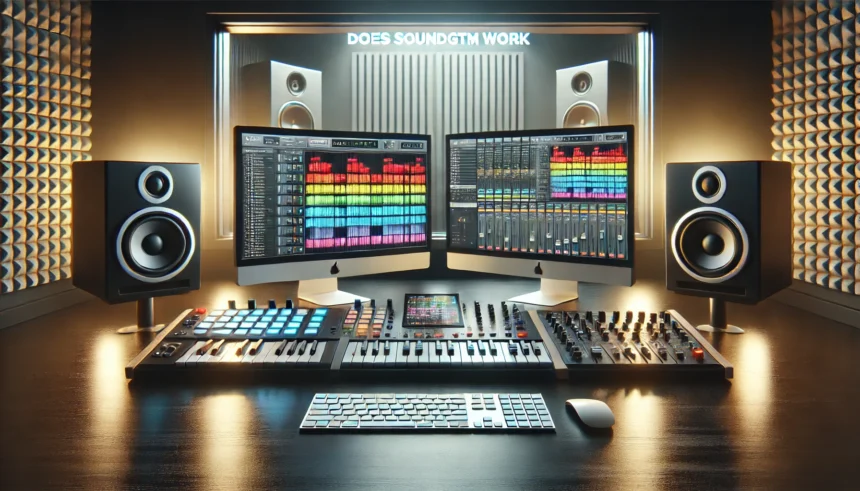Audio content has become an essential part of modern digital experiences, from podcasts to online courses and music streaming platforms. But how can businesses and content creators measure user engagement with their audio content? That’s where SoundGTM comes in. This article will break down how does SoundGTM work, its benefits, and how you can leverage it to optimize your audio content.
What is SoundGTM?
SoundGTM refers to the integration of audio tracking capabilities with tools like Google Tag Manager (GTM). By using SoundGTM, website owners, content creators, and marketers can track how users interact with audio content on their platforms.
For example, you can monitor when a user clicks “play” on a podcast, pauses an audio track, or listens to a piece of music from start to finish. This data provides valuable insights into user behavior, helping you improve content strategies and user engagement.
How Does SoundGTM Work?
Now, let’s explore how does SoundGTM work in detail. The process can be summarized in three key steps:
Collecting User Interaction Data
SoundGTM captures real-time data on user interactions with audio files embedded on your website or app. These interactions include actions like:
- Clicking the play button.
- Pausing or resuming an audio file.
- Skipping forward or backward.
- Listening to the audio in full.
Integration with Google Tag Manager
SoundGTM integrates seamlessly with Google Tag Manager (GTM), a powerful tool used to manage tracking tags on websites. By setting up specific tags and triggers in GTM, you can track user interactions with audio content and send this data to analytics platforms like Google Analytics.
Analytics and Reporting
Once the data is collected, it is sent to your analytics platform. This allows you to analyze user behavior, such as:
- How many users are listening to your audio content.
- Average listening duration.
- The percentage of users completing an audio file.
- User drop-off points (where they stop listening).
By understanding this data, you can make informed decisions about your audio strategy.
Benefits of Using SoundGTM
Understanding how does SoundGTM work is just the beginning. Here are some benefits of using SoundGTM for your website or app:
Improved User Insights
SoundGTM helps you gain a deeper understanding of how users engage with your audio content. For example, if users frequently stop listening after a certain point, you can identify areas for improvement.
Enhanced Content Strategy
By analyzing user behavior, you can create more engaging audio content tailored to your audience’s preferences. This is particularly useful for podcasters and music platforms.
Optimized Marketing Campaigns
Tracking audio interactions allows you to measure the effectiveness of audio ads or promotional content, ensuring your campaigns deliver better results.
Better User Experience
By identifying how users interact with audio, you can optimize your website or app’s audio features to create a seamless experience.
How to Set Up SoundGTM for Your Website/App
Here’s a step-by-step guide on how to implement SoundGTM on your platform:
Add the Audio Player
Ensure your website or app has an audio player that supports event tracking, such as an HTML5 audio player or third-party plugin.
Configure Google Tag Manager
- Create a new tag in GTM for audio tracking.
- Set up triggers for specific actions, such as “play” or “pause.”
- Use variables to capture additional data like the audio file name or duration.
Test and Publish
- Use GTM’s preview mode to test your setup and ensure data is captured correctly.
- Publish your changes and monitor the results in your analytics platform.
Real-Life Use Cases for SoundGTM
Let’s look at how SoundGTM can be applied in real-life scenarios:
Podcast Platforms
Podcast creators can track how many listeners play their episodes, how long they listen, and where they drop off. This data can help improve podcast content and identify popular topics.
Music Streaming Sites
Music platforms can monitor user preferences, such as frequently played songs, skipped tracks, or the time users spend listening.
E-Learning Platforms
Online learning platforms can track student engagement with audio lessons, such as lectures or language practice tracks.
Common Challenges with SoundGTM
While understanding how does SoundGTM work is straightforward, you may encounter some challenges during implementation:
Compatibility Issues
Some audio players may not support event tracking, requiring additional customization.
Misfiring Triggers
Triggers may not fire correctly if the GTM setup is not configured properly. Testing is essential to avoid errors.
Data Accuracy
Ensuring accurate data collection requires proper setup and monitoring.
To overcome these challenges, follow best practices and test your setup thoroughly.
Advanced Features of SoundGTM
For those looking to go beyond basic tracking, here are some advanced features of SoundGTM:
Tracking Completion Rates
Monitor how many users listen to an audio file from start to finish. This is crucial for understanding user engagement.
Measuring Skip and Replay Actions
Track how often users skip forward or replay sections of an audio file. This can reveal the most engaging or least engaging parts of your content.
Listening Duration Analysis
Analyze how long users spend listening to audio on average, providing insights into content quality and user interest.
Conclusion
In conclusion, SoundGTM is a powerful tool for tracking and analyzing audio interactions on your website or app. By understanding how does SoundGTM work, you can gain valuable insights into user behavior, optimize your content strategy, and create a better user experience.
Whether you’re a podcaster, a music platform owner, or an e-learning provider, SoundGTM can help you unlock the full potential of your audio content. Start integrating SoundGTM today and see the difference it can make for your business.
Frequently Asked Questions (FAQs)
What is SoundGTM and how does it work?
SoundGTM is a tool for tracking audio interactions using Google Tag Manager, helping analyze user engagement with audio content like podcasts or music.
How does SoundGTM work with Google Tag Manager?
SoundGTM integrates with GTM by setting up tags and triggers to track audio events, such as play, pause, and completion.
Why is it important to know how SoundGTM works?
Understanding how SoundGTM works helps optimize audio content, improve user experience, and gather valuable analytics data.
How does SoundGTM track audio interactions?
SoundGTM tracks audio by monitoring user actions, like listening duration, skip events, and playback completion, through GTM triggers.
Can beginners easily learn how does SoundGTM work?
Yes, with step-by-step guidance, beginners can quickly learn to implement SoundGTM for audio tracking on websites or apps.
Recommended Article:
Understanding 727-398-3269 Phone Number: Is It a Scam?
izonemedia360 .com mobile: Access the Untapped Potential of Smartphone Marketing Answers
Comprehensive Guide to HTR Lotto.apk: Features, Benefits, and Safety Tips






